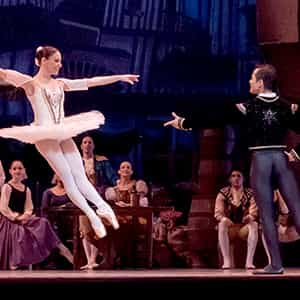

Classical and Neoclassical Ballets Tickets
No Buyer Fees on Classical and Neoclassica.. Tickets and Up to 30% Off Compared to Competitors. Learn More →
Select Location (e.g, New York)
Events Nearby
Classical and Neoclassical Ballets Cities & Venues
Frequently Asked Questions About Classical and Neoclassical Ballets Tickets and Events
What are the key characteristics that define Classical and Neoclassical ballet forms?
Classical ballet emphasizes strict techniques, graceful movements, and strong narratives, while neoclassical ballet incorporates traditional elements with modern innovations, focusing on abstraction and expressiveness.
How does the choreography in Neoclassical ballet differ from that of Classical ballet?
Neoclassical ballet often features quicker tempos, less rigid structures, and greater spatial dynamics compared to the more formal, narrative-driven choreography of Classical ballet.
What role does music play in the performance of Classical and Neoclassical ballet?
Music serves as a crucial element, enhancing the emotional expression and complementing the choreography, with Classical often relying on symphonic scores and Neoclassical experimenting with contemporary compositions.
Who are some of the most influential choreographers in the history of Classical and Neoclassical ballet?
Influential choreographers include Marius Petipa and George Balanchine, who significantly shaped the development of Classical and Neoclassical ballet styles, respectively.
What techniques are essential for dancers performing in Classical and Neoclassical ballets?
Essential techniques include proper alignment, turn-out, jumping, and balance, with both forms requiring rigorous training and discipline to execute intricate movements and positions.
How do costume designs in Classical and Neoclassical ballets reflect their respective styles?
Classical ballet costumes are typically elaborate and convey specific character traits, while Neoclassical costumes tend to be more streamlined, allowing for greater freedom of movement and emphasizing the body's lines.
What themes are commonly explored in Classical and Neoclassical ballet performances?
Classical ballets often explore themes of love, tragedy, and fantasy, while Neoclassical works may focus on abstract concepts and the exploration of form, movement, and emotion without a strict narrative.
What training is recommended for dancers aspiring to master Classical and Neoclassical ballet styles?
Aspiring dancers should undergo rigorous training in classical ballet technique, participate in workshops, and take classes that focus on both traditional and contemporary styles to develop versatility.
How does the audience's experience differ between attending a Classical ballet and a Neoclassical ballet?
Audiences may find Classical ballet to be more narrative-driven and visually enchanting, while Neoclassical ballet might offer a more abstract and emotive experience, inviting personal interpretation.
What are the most famous Classical and Neoclassical ballets that showcase their distinct styles?
Famous Classical ballets include 'Swan Lake' and 'The Nutcracker,' while notable Neoclassical works feature 'Agon' and 'The Four Temperaments,' highlighting the evolution of ballet through different eras.

